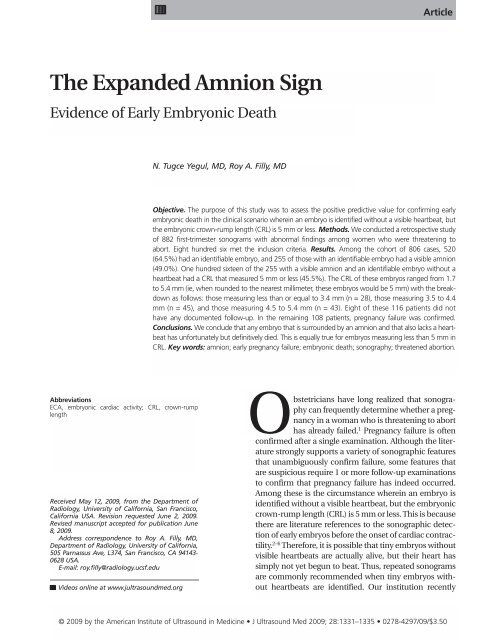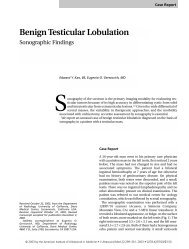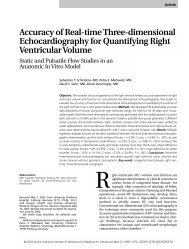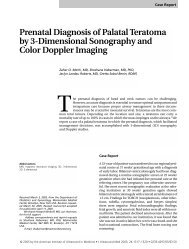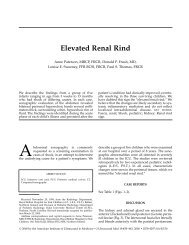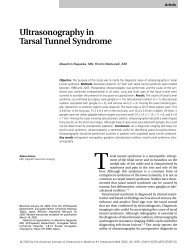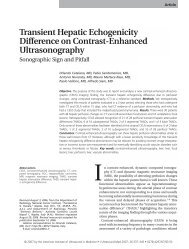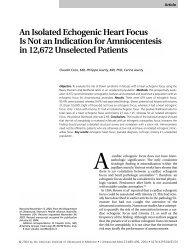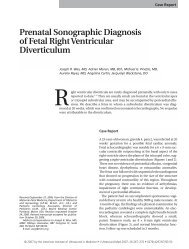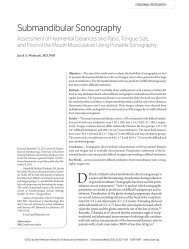The Expanded Amnion Sign - Journal of Ultrasound in Medicine
The Expanded Amnion Sign - Journal of Ultrasound in Medicine
The Expanded Amnion Sign - Journal of Ultrasound in Medicine
Create successful ePaper yourself
Turn your PDF publications into a flip-book with our unique Google optimized e-Paper software.
<strong>The</strong> <strong>Expanded</strong> <strong>Amnion</strong> <strong>Sign</strong><br />
Evidence <strong>of</strong> Early Embryonic Death<br />
Abbreviations<br />
ECA, embryonic cardiac activity; CRL, crown-rump<br />
length<br />
Received May 12, 2009, from the Department <strong>of</strong><br />
Radiology, University <strong>of</strong> California, San Francisco,<br />
California USA. Revision requested June 2, 2009.<br />
Revised manuscript accepted for publication June<br />
8, 2009.<br />
Address correspondence to Roy A. Filly, MD,<br />
Department <strong>of</strong> Radiology, University <strong>of</strong> California,<br />
505 Parnassus Ave, L374, San Francisco, CA 94143-<br />
0628 USA.<br />
E-mail: roy.filly@radiology.ucsf.edu<br />
Videos onl<strong>in</strong>e at www.jultrasoundmed.org<br />
N. Tugce Yegul, MD, Roy A. Filly, MD<br />
Article<br />
Objective. <strong>The</strong> purpose <strong>of</strong> this study was to assess the positive predictive value for confirm<strong>in</strong>g early<br />
embryonic death <strong>in</strong> the cl<strong>in</strong>ical scenario where<strong>in</strong> an embryo is identified without a visible heartbeat, but<br />
the embryonic crown-rump length (CRL) is 5 mm or less. Methods. We conducted a retrospective study<br />
<strong>of</strong> 882 first-trimester sonograms with abnormal f<strong>in</strong>d<strong>in</strong>gs among women who were threaten<strong>in</strong>g to<br />
abort. Eight hundred six met the <strong>in</strong>clusion criteria. Results. Among the cohort <strong>of</strong> 806 cases, 520<br />
(64.5%) had an identifiable embryo, and 255 <strong>of</strong> those with an identifiable embryo had a visible amnion<br />
(49.0%). One hundred sixteen <strong>of</strong> the 255 with a visible amnion and an identifiable embryo without a<br />
heartbeat had a CRL that measured 5 mm or less (45.5%). <strong>The</strong> CRL <strong>of</strong> these embryos ranged from 1.7<br />
to 5.4 mm (ie, when rounded to the nearest millimeter, these embryos would be 5 mm) with the breakdown<br />
as follows: those measur<strong>in</strong>g less than or equal to 3.4 mm (n = 28), those measur<strong>in</strong>g 3.5 to 4.4<br />
mm (n = 45), and those measur<strong>in</strong>g 4.5 to 5.4 mm (n = 43). Eight <strong>of</strong> these 116 patients did not<br />
have any documented follow-up. In the rema<strong>in</strong><strong>in</strong>g 108 patients, pregnancy failure was confirmed.<br />
Conclusions. We conclude that any embryo that is surrounded by an amnion and that also lacks a heartbeat<br />
has unfortunately but def<strong>in</strong>itively died. This is equally true for embryos measur<strong>in</strong>g less than 5 mm <strong>in</strong><br />
CRL. Key words: amnion; early pregnancy failure; embryonic death; sonography; threatened abortion.<br />
bstetricians have long realized that sonography<br />
can frequently determ<strong>in</strong>e whether a pregnancy<br />
<strong>in</strong> a woman who is threaten<strong>in</strong>g to abort<br />
has already failed. 1 Pregnancy failure is <strong>of</strong>ten<br />
confirmed after a s<strong>in</strong>gle exam<strong>in</strong>ation. Although the literature<br />
strongly supports a variety <strong>of</strong> sonographic features<br />
that unambiguously confirm failure, some features that<br />
are suspicious require 1 or more follow-up exam<strong>in</strong>ations<br />
to confirm that pregnancy failure has <strong>in</strong>deed occurred.<br />
Among these is the circumstance where<strong>in</strong> an embryo is<br />
identified without a visible heartbeat, but the embryonic<br />
crown-rump length (CRL) is 5 mm or less. This is because<br />
there are literature references to the sonographic detection<br />
<strong>of</strong> early embryos before the onset <strong>of</strong> cardiac contractility.<br />
2–6 O<br />
<strong>The</strong>refore, it is possible that t<strong>in</strong>y embryos without<br />
visible heartbeats are actually alive, but their heart has<br />
simply not yet begun to beat. Thus, repeated sonograms<br />
are commonly recommended when t<strong>in</strong>y embryos without<br />
heartbeats are identified. Our <strong>in</strong>stitution recently<br />
© 2009 by the American Institute <strong>of</strong> <strong>Ultrasound</strong> <strong>in</strong> Medic<strong>in</strong>e J <strong>Ultrasound</strong> Med 2009; 28:1331–1335 0278-4297/09/$3.50
<strong>The</strong> <strong>Expanded</strong> <strong>Amnion</strong> <strong>Sign</strong><br />
1332<br />
reported that <strong>in</strong> a series <strong>of</strong> 37 such embryos consecutively<br />
seen over a 4-year period <strong>in</strong> women<br />
who were threaten<strong>in</strong>g to abort, none subsequently<br />
had a normal obstetric delivery or development<br />
<strong>of</strong> embryonic cardiac activity (ECA) but<br />
<strong>in</strong>stead were confirmed as early pregnancy failures.<br />
7 Our results were similar to those <strong>of</strong> Levi et<br />
al 4 when their data were conf<strong>in</strong>ed to women with<br />
vag<strong>in</strong>al bleed<strong>in</strong>g.<br />
Nonetheless, practitioners will likely still feel a<br />
need to recommend follow-up exam<strong>in</strong>ations<br />
when an embryo is identified without a visible<br />
heartbeat, but the embryonic CRL is 5 mm or less<br />
because this has been a long-held belief. In this<br />
article, we report our observations <strong>of</strong> what we<br />
have termed the “expanded amnion sign” to<br />
describe a feature that confirms early embryonic<br />
death <strong>in</strong> the cl<strong>in</strong>ical scenario where<strong>in</strong> an<br />
embryo is identified without a visible heartbeat,<br />
but the embryonic CRL is 5 mm or less. In 1995,<br />
we observed that at the earliest sonographically<br />
visible stages <strong>of</strong> amnion identification, there was<br />
a l<strong>in</strong>ear relationship <strong>of</strong> amnion diameter to CRL. 8<br />
Thus, by the time that a relatively complete<br />
amnion is visualized, an embryo with a CRL <strong>of</strong> at<br />
least 7 mm (and usually larger) should be detected<br />
with<strong>in</strong> its conf<strong>in</strong>es (Video 1). Horrow 9 <strong>in</strong>itially<br />
suggested this observation but <strong>in</strong>stead computed<br />
the menstrual age at which the amnion was<br />
first seen as 6.5 weeks, at which time the CRL<br />
equals 7 mm. All embryos with a CRL <strong>of</strong> 7 mm or<br />
greater would necessarily have a visible heartbeat<br />
if alive. Ikegawa 10 later studied 1 group each<br />
<strong>of</strong> normal and failed pregnancies relative to<br />
amnion detection rates and also concurred that<br />
the amnion was not detectable <strong>in</strong> normal pregnancies<br />
until the embryo achieved a CRL <strong>of</strong> 7<br />
mm or greater. Although his data produced only<br />
10 cases meet<strong>in</strong>g the criteria <strong>in</strong> our study,<br />
Ikegawa 10 suggested that an enlarged amniotic<br />
sac surround<strong>in</strong>g an embryo <strong>of</strong> less than 7 mm<br />
that also failed to show cardiac activity suggested<br />
pregnancy failure. In this study, we <strong>in</strong>vestigated a<br />
consecutive series <strong>of</strong> early pregnancies <strong>in</strong> which<br />
an embryo with a CRL <strong>of</strong> 5 mm or less and lack<strong>in</strong>g<br />
a heartbeat was identified, but surround<strong>in</strong>g<br />
the embryo, one could also see the amnion. We<br />
calculated the positive predictive value <strong>of</strong> this<br />
f<strong>in</strong>d<strong>in</strong>g to confirm early pregnancy failure <strong>in</strong> this<br />
patient cohort.<br />
Materials and Methods<br />
A retrospective review <strong>of</strong> the University <strong>of</strong><br />
California San Francisco Medical Center ultrasound<br />
database from January 1999 to October<br />
2008 revealed 882 first-trimester sonograms<br />
among women who were threaten<strong>in</strong>g to abort<br />
and had abnormal sonographic f<strong>in</strong>d<strong>in</strong>gs <strong>in</strong>clud<strong>in</strong>g<br />
the <strong>in</strong>ability to show a fetal heartbeat. All <strong>of</strong><br />
these sonograms were reviewed for the presence<br />
<strong>of</strong> an embryo and a visible amniotic sac. To confirm<br />
amniotic sac visualization, both the yolk sac<br />
and the amnion needed to be visualized, thus<br />
exclud<strong>in</strong>g large yolk sacs as a possible explanation<br />
<strong>of</strong> amnion identification. Of course, an<br />
embryo resides with<strong>in</strong> the amnion, not with<strong>in</strong><br />
the yolk sac. Thus, it is sufficient to identify the<br />
embryo to confirm that the surround<strong>in</strong>g membrane<br />
is the amnion (Figure 1). However, we<br />
used the more str<strong>in</strong>gent criterion <strong>of</strong> visualization<br />
<strong>of</strong> both the yolk sac and the amnion.<br />
Follow-up sonograms <strong>of</strong> the same pregnancy (n<br />
= 45) were excluded (other than for confirmation<br />
Figure 1. All sonograms <strong>in</strong> our patient cohort were reviewed for<br />
the presence <strong>of</strong> an embryo and a visible amniotic sac.<br />
Visualization <strong>of</strong> both the yolk sac and the amnion excluded large<br />
yolk sacs as a possible explanation for amnion identification. Of<br />
course, the embryo resides with<strong>in</strong> the amnion, not with<strong>in</strong> the<br />
yolk sac. Thus, it is sufficient to identify the embryo to confirm<br />
that the surround<strong>in</strong>g membrane is the amnion.<br />
J <strong>Ultrasound</strong> Med 2009; 28:1331–1335
<strong>of</strong> pregnancy failure or cont<strong>in</strong>uation). Thirtyone<br />
<strong>of</strong> the sonograms were not retrievable at the<br />
time <strong>of</strong> the review and were also excluded.<br />
<strong>The</strong>refore, 806 sonograms were <strong>in</strong>cluded <strong>in</strong> the<br />
study. <strong>The</strong> University <strong>of</strong> California San Francisco<br />
Committee on Human Research approved the<br />
study.<br />
Each patient was scanned with both transabdom<strong>in</strong>al<br />
and endovag<strong>in</strong>al techniques (Acuson<br />
Sequoia; Siemens Medical Solutions, Mounta<strong>in</strong><br />
View, CA) per <strong>in</strong>stitutional protocol by a sonographer.<br />
Transabdom<strong>in</strong>al transducers used<br />
<strong>in</strong>cluded vector arrays with selectable frequencies<br />
rang<strong>in</strong>g from 1 to 4 MHz and curved arrays<br />
with selectable frequencies rang<strong>in</strong>g from 2 to 6<br />
MHz. <strong>The</strong> endovag<strong>in</strong>al transducer used was a<br />
tightly curved array with selectable frequencies<br />
rang<strong>in</strong>g from 4 to 8 MHz. Because the ultrasound<br />
unit computes the CRL to the nearest tenth <strong>of</strong> a<br />
millimeter, the CRL was rounded to the nearest<br />
millimeter for purposes <strong>of</strong> data analysis.<br />
<strong>The</strong> electronic medical records <strong>of</strong> these patients<br />
were reviewed to determ<strong>in</strong>e the pregnancy outcome.<br />
Pregnancy failure was confirmed if any <strong>of</strong><br />
the follow<strong>in</strong>g were seen with<strong>in</strong> 6 months <strong>of</strong> the<br />
first sonogram: pathologically proven embryonic<br />
death, a follow-up sonogram show<strong>in</strong>g embryonic<br />
death, a sonogram show<strong>in</strong>g a new firsttrimester<br />
<strong>in</strong>trauter<strong>in</strong>e pregnancy, laboratory<br />
results show<strong>in</strong>g decreas<strong>in</strong>g β-human chorionic<br />
gonadotrop<strong>in</strong> levels, or a cl<strong>in</strong>ical note <strong>in</strong>dicat<strong>in</strong>g<br />
spontaneous abortion.<br />
Results<br />
Among the cohort <strong>of</strong> 806 cases, 520 (64.5%) had<br />
an identifiable embryo, and 255 <strong>of</strong> those with an<br />
identifiable embryo had a visible amnion (49.0%;<br />
Table 1). As stated above, none <strong>of</strong> the embryos<br />
had a visible heartbeat. One hundred sixteen <strong>of</strong><br />
the 255 cases with a visible amnion and an identifiable<br />
embryo without a heartbeat had a CRL<br />
that measured 5 mm or less (45.5%; Figure 2 and<br />
Video 2). <strong>The</strong> CRL <strong>of</strong> these embryos ranged from<br />
1.7 to 5.4 mm (ie, when rounded to the nearest<br />
millimeter, these embryos would be 5 mm) with<br />
the breakdown as follows: those measur<strong>in</strong>g less<br />
than or equal to 3.4 mm (n = 28), those measur<strong>in</strong>g<br />
3.5 to 4.4 mm (n = 45), and those measur<strong>in</strong>g<br />
4.5 to 5.4 mm (n = 43).<br />
Table 1. Data Analysis Related to Embryo Size<br />
Eight <strong>of</strong> these 116 patients did not have any<br />
documented follow-up. In the rema<strong>in</strong><strong>in</strong>g 108<br />
patients, pregnancy failure was confirmed.<br />
<strong>The</strong>refore, on the basis <strong>of</strong> the results <strong>of</strong> our study,<br />
the positive predictive value <strong>of</strong> the expanded<br />
amnion sign <strong>in</strong> determ<strong>in</strong><strong>in</strong>g early pregnancy failure<br />
was 100%.<br />
Discussion<br />
Sonography’s track record for determ<strong>in</strong><strong>in</strong>g<br />
whether an early pregnancy has already failed<br />
has made this exam<strong>in</strong>ation pivotal <strong>in</strong> the management<br />
<strong>of</strong> pregnancies with bleed<strong>in</strong>g <strong>in</strong> the first<br />
Figure 2. Endovag<strong>in</strong>al sonogram <strong>of</strong> a t<strong>in</strong>y embryo surrounded<br />
by an amniotic sac, a sac too large for the observed CRL. As<br />
noted <strong>in</strong> the <strong>in</strong>troductory text, for very early embryos, the CRL is<br />
l<strong>in</strong>early related to the amnion diameter. Thus, this embryo should<br />
have had a CRL <strong>of</strong> approximately 10 mm, much larger than <strong>in</strong><br />
this case. Note also that the entirety <strong>of</strong> the amnion is visible as a<br />
complete membrane encircl<strong>in</strong>g the embryo. Compare with<br />
Video 1.<br />
Yegul and Filly<br />
Embryos <strong>Amnion</strong> Seen <strong>Amnion</strong> Not Seen Total<br />
≤5.4 mm a 116 b 43 159<br />
>5.4 mm a 139 222 361<br />
Total 255 265 520<br />
a None <strong>of</strong> the embryos had a heartbeat.<br />
b All <strong>of</strong> these cases could be confidently diagnosed as pregnancy failures<br />
even though the embryos had a CRL <strong>of</strong> 5 mm or less. Thus, 116 <strong>of</strong> 159 small<br />
embryos (73%) could be diagnosed with confidence.<br />
J <strong>Ultrasound</strong> Med 2009; 28:1331–1335 1333
<strong>The</strong> <strong>Expanded</strong> <strong>Amnion</strong> <strong>Sign</strong><br />
1334<br />
trimester. 1–8 This is because pregnancy failure<br />
<strong>of</strong>ten can be confirmed with a s<strong>in</strong>gle exam<strong>in</strong>ation<br />
performed <strong>in</strong> less than 30 m<strong>in</strong>utes. As noted<br />
above, the literature supports that a variety <strong>of</strong><br />
sonographic features unambiguously confirm<br />
early pregnancy failure.<br />
Previous studies have cautioned that there are<br />
embryos with a CRL <strong>of</strong> 5 mm or less and without<br />
sonographically detectable ECA that may be<br />
alive because the embryo’s heart has not yet<br />
begun to beat. 2,3,5,6,8 More recent studies have<br />
suggested that 3 mm, not 5 mm, should be the<br />
new cut<strong>of</strong>f 4,7 for diagnosis <strong>of</strong> death if ECA is not<br />
seen. Yet another study went to the opposite<br />
extreme and recommended us<strong>in</strong>g a CRL <strong>of</strong> 10<br />
mm as the cut<strong>of</strong>f before diagnos<strong>in</strong>g embryonic<br />
death. 11 <strong>The</strong>se recommendations usually necessitate<br />
a follow-up sonographic exam<strong>in</strong>ation, thus<br />
<strong>in</strong>curr<strong>in</strong>g additional medical costs and further<strong>in</strong>g<br />
maternal uncerta<strong>in</strong>ty regard<strong>in</strong>g the status <strong>of</strong><br />
the pregnancy. We recently published outcomes<br />
<strong>of</strong> embryos with a CRL <strong>of</strong> 5 mm or less without<br />
ECA among 546 women with vag<strong>in</strong>al bleed<strong>in</strong>g.<br />
None <strong>of</strong> these embryos later proved to be alive.<br />
Although embryos without ECA and a CRL <strong>of</strong><br />
less than 5 mm have progressed to normal<br />
pregnancies <strong>in</strong> asymptomatic women, our<br />
results and those <strong>of</strong> Levi et al 4 <strong>in</strong> bleed<strong>in</strong>g<br />
women showed that there were no successful<br />
pregnancies <strong>in</strong> either cohort, and follow-up<br />
sonography may be superfluous. 7 <strong>The</strong> data from<br />
this study show that if an embryo with a CRL <strong>of</strong> 5<br />
mm or less and without sonographically<br />
detectable ECA is also surrounded by an amnion,<br />
a virtually certa<strong>in</strong> diagnosis <strong>of</strong> embryonic death<br />
can be made. Horrow 9 also suspected as early as<br />
1992 that this observation identified failed pregnancies<br />
but thought that her sample size was too<br />
small to draw def<strong>in</strong>itive conclusions.<br />
Another problem solved by the expanded<br />
amnion sign described here<strong>in</strong> is the so-called<br />
chorionic bump. 12 This feature may be mistaken<br />
for an embryo without ECA. However, if the<br />
embryo is surrounded by amnion, then the<br />
exam<strong>in</strong>er can be certa<strong>in</strong> that it is not a chorionic<br />
bump. Recall that among the 806 sonograms<br />
<strong>in</strong>cluded <strong>in</strong> the study, 326 (40.4%) had a visible<br />
amnion. Thus, with modern endovag<strong>in</strong>al transducers,<br />
amnion visualization is common.<br />
Because we used endovag<strong>in</strong>al transducers with<br />
selectable frequencies from 4 to 8 MHz, we were<br />
not us<strong>in</strong>g the current state-<strong>of</strong>-the-art transducers<br />
available that image at frequencies <strong>of</strong> greater<br />
than 8 MHz. <strong>The</strong>refore, it is probable that future<br />
studies will show even higher proportions <strong>of</strong><br />
early pregnancy failure where<strong>in</strong> the amnion is<br />
visualized.<br />
Although it would be preferable to confirm our<br />
results prospectively, we th<strong>in</strong>k that this f<strong>in</strong>d<strong>in</strong>g,<br />
the expanded amnion sign, can be effectively<br />
used with confidence on the basis <strong>of</strong> the results<br />
<strong>of</strong> this retrospective study alone. We conclude<br />
that any embryo that is surrounded by an<br />
amnion and that also lacks a heartbeat has<br />
unfortunately but def<strong>in</strong>itively died. This is equally<br />
true for embryos measur<strong>in</strong>g less than 5 mm <strong>in</strong><br />
CRL. Furthermore, the ability to show the amnion<br />
<strong>in</strong> this circumstance is common. Among embryos<br />
lack<strong>in</strong>g a heartbeat and hav<strong>in</strong>g a CRL <strong>of</strong> less than<br />
5 mm, 116 <strong>of</strong> 159 cases (73%) had a visible<br />
amnion.<br />
References<br />
1. La<strong>in</strong>g FC, Frates MC, Benson CB. <strong>Ultrasound</strong> evaluation<br />
dur<strong>in</strong>g the first trimester <strong>of</strong> pregnancy. In: Callen PW (ed).<br />
Ultrasonography <strong>in</strong> Obstetrics and Gynecology. 5th ed.<br />
Philadelphia, PA: WB Saunders Co; 2008:181–224.<br />
2. Brown DL, Emerson DS, Felker RE, Cartier MS, Smith WC.<br />
Diagnosis <strong>of</strong> early embryonic demise by endovag<strong>in</strong>al<br />
sonography. J <strong>Ultrasound</strong> Med 1990; 9:631–636.<br />
3. Goldste<strong>in</strong> RB. Endovag<strong>in</strong>al sonography <strong>in</strong> very early pregnancy:<br />
new observations. Radiology 1990; 176:7–8.<br />
4. Levi CS, Lyons EA, Zheng XH, L<strong>in</strong>dsay DJ, Holt SC.<br />
Endovag<strong>in</strong>al US: demonstration <strong>of</strong> cardiac activity <strong>in</strong><br />
embryos <strong>of</strong> less than 5.0 mm <strong>in</strong> crown-rump length.<br />
Radiology 1990; 176:71–74.<br />
5. Pennell RG, Needleman L, Pajak T, et al. Prospective comparison<br />
<strong>of</strong> vag<strong>in</strong>al and abdom<strong>in</strong>al sonography <strong>in</strong> normal<br />
early pregnancy. J <strong>Ultrasound</strong> Med 1991; 10:63–67.<br />
6. Schouw<strong>in</strong>k MH, Fong BF, Mol BW, van der Veen F.<br />
Ultrasonographic criteria for non-viability <strong>of</strong> first trimester<br />
<strong>in</strong>tra-uter<strong>in</strong>e pregnancy. Early Pregnancy 2000; 4:203–213.<br />
7. Aziz S, Cho RC, Baker DB, Chhor C, Filly RA. Five-millimeter<br />
and smaller embryos without embryonic cardiac activity:<br />
outcomes <strong>in</strong> women with vag<strong>in</strong>al bleed<strong>in</strong>g. J <strong>Ultrasound</strong><br />
Med 2008; 27:1559–1561.<br />
8. McKenna KM, Feldste<strong>in</strong> VA, Goldste<strong>in</strong> RB, Filly RA. <strong>The</strong><br />
empty amnion: a sign <strong>of</strong> early pregnancy failure.<br />
J <strong>Ultrasound</strong> Med 1995; 14:117–121.<br />
9. Horrow MM. Enlarged amniotic cavity: a new sonographic<br />
sign <strong>of</strong> early embryonic death. AJR Am J Roentgenol 1992;<br />
158:359–362.<br />
J <strong>Ultrasound</strong> Med 2009; 28:1331–1335
10. Ikegawa A. First-trimester detection <strong>of</strong> amniotic sac <strong>in</strong> relation<br />
to miscarriage. J Obstet Gynaecol Res 1997; 23:283–<br />
288.<br />
11. Hately W, Case J, Campbell S. Establish<strong>in</strong>g the death <strong>of</strong> an<br />
embryo by ultrasound: report <strong>of</strong> a public <strong>in</strong>quiry with recommendations.<br />
<strong>Ultrasound</strong> Obstet Gynecol 1995;<br />
5:353–357.<br />
12. Harris RD, Couto C, Karpovsky C, Porter MM, Ouhilal S.<br />
<strong>The</strong> chorionic bump: a first-trimester pregnancy sonographic<br />
f<strong>in</strong>d<strong>in</strong>g associated with a guarded prognosis.<br />
J <strong>Ultrasound</strong> Med 2006; 25:757–763.<br />
Yegul and Filly<br />
J <strong>Ultrasound</strong> Med 2009; 28:1331–1335 1335


